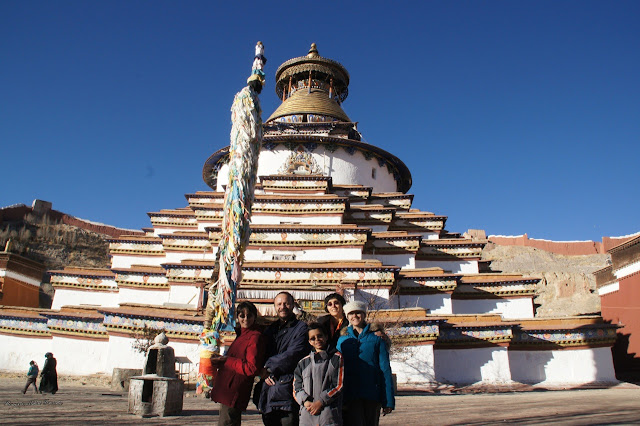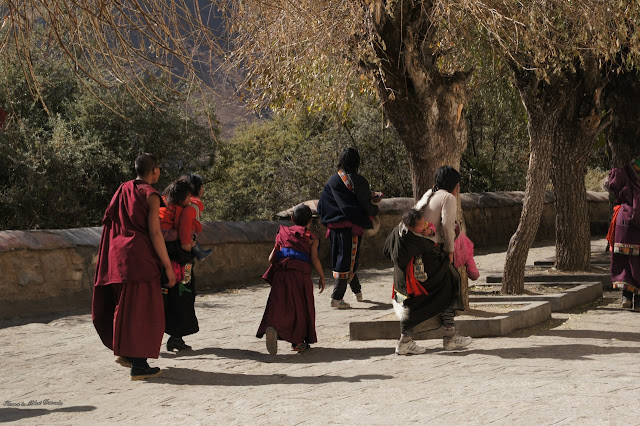Before we left, there were several occasions in which friends could have offered good bye gifts. We decided to organize a "fun" fund raiser, mostly around our good bye party. It was for the children, for special meals, trips or trinkets. The fund got increased considerably by a good bye gift from my coworkers, then by the gift that the children received from Emma. Then it all got dwarfed by the contribution of the grandparents, when we met with them in Beijing, but that's another story. We want to keep track of these gifts, it will give us a chance for more fun and celebrations and also a chance to bring up our friends during our conversations. If you want to contribute, there is a link at the top of the blog "donate."
So we travelled through Tibet for several days, tough time but also amazing experience. We ate when and where we could, picking with hesitation some of the offers. Most of the time we got lucky, the food was edible. Sometimes we had something great, but not what we knew and what we loved. We've been on the road for 6-7 weeks (who's counting?). All of the time, in foreign countries, with different language, different cuisine, different ingredients and different tastes. We were initially excited in Japan and we had some great meals, but it's Japan, we didn't find the cheapest options and we skipped meals several times. We lived in two apartments and had a chance to cook some rice and that made it more tolerable. We did have a fridge so we could keep some butter or cheese or salami. The milk was great and we could find yogurt.
In China, we lived in hotel rooms. At most restaurants we chose things by pictures, it looked like meat sometimes, but had no idea what animal it was. Sometimes it was a dessert, sometimes something inedible. We took it in stride for a while. We had a great meal when we had the Peking duck, we had some decent meals on a few occasions. As Ileana knew how to say rice, we were able to order that for the children and they were happy. When I met with my parents, my mom and my aunt saved for the kids some of the cheese and butter they got for breakfast in their four star hotel. After a while we got tired of this. We ate a couple of times at KFC, once at Dico's, a Chinese copy. At least they had a menu in English and we knew we got chicken. We got snacks from some food stores. They have instant noodles, prepackaged, you just have to add boiling water, that was our meal on several occasions. We were careful with fruits and vegetables, but got good apples and bananas. I could never find any sort of cheese in China! Twice I bought a package of Viennese sausages, regularly I bought crackers. With her illness making things harder, at one point, Ileana Ruxandra just had enough of the spicy hot Chinese food. She didn't explain what alternative she had in mind and she agreed to try eating again after a bit.
Arrived in Tibet, we had a guide, she took us to a couple of restaurants and we had some good food. First time, it was the first cooked meal in a week! What I didn't like in the restaurants in Lhasa was that they had between 150 and 225 choices of meals, you could choose from various cuisines and you would get your meal in minutes! They seem to have everything on hand, but these are restaurants that might have only 5 or 25 customers per night. I was really excited when they once said they don't have a particular product. They didn't have fries!
Traveling with our guide through Tibet, she stopped at small restaurants that she knew and we had decent meals, nothing special, it was not touristic season and we might have been their only guests for the day or for the week. In Shigatse we had a scale in the room and Ileana Ruxandra lost a couple of pounds, Maria might have lost one (she's never hungry!), Ileana thinks she lost 8. I lost 22 (10kg)! This is actually good news, because they were long overdue.
So on our 45th day of our trip, we entered Nepal, travelled for 5 hours to our hotel and settled in. It was time for dinner and we were in a new country! Where to go? We chose the restaurant downstairs, Alchemy. It seemed to be Italian food and the children wanted a pizza. We didn't have high expectations, maybe we got a bit scared when we saw high class and the high prices.
So we travelled through Tibet for several days, tough time but also amazing experience. We ate when and where we could, picking with hesitation some of the offers. Most of the time we got lucky, the food was edible. Sometimes we had something great, but not what we knew and what we loved. We've been on the road for 6-7 weeks (who's counting?). All of the time, in foreign countries, with different language, different cuisine, different ingredients and different tastes. We were initially excited in Japan and we had some great meals, but it's Japan, we didn't find the cheapest options and we skipped meals several times. We lived in two apartments and had a chance to cook some rice and that made it more tolerable. We did have a fridge so we could keep some butter or cheese or salami. The milk was great and we could find yogurt.
In China, we lived in hotel rooms. At most restaurants we chose things by pictures, it looked like meat sometimes, but had no idea what animal it was. Sometimes it was a dessert, sometimes something inedible. We took it in stride for a while. We had a great meal when we had the Peking duck, we had some decent meals on a few occasions. As Ileana knew how to say rice, we were able to order that for the children and they were happy. When I met with my parents, my mom and my aunt saved for the kids some of the cheese and butter they got for breakfast in their four star hotel. After a while we got tired of this. We ate a couple of times at KFC, once at Dico's, a Chinese copy. At least they had a menu in English and we knew we got chicken. We got snacks from some food stores. They have instant noodles, prepackaged, you just have to add boiling water, that was our meal on several occasions. We were careful with fruits and vegetables, but got good apples and bananas. I could never find any sort of cheese in China! Twice I bought a package of Viennese sausages, regularly I bought crackers. With her illness making things harder, at one point, Ileana Ruxandra just had enough of the spicy hot Chinese food. She didn't explain what alternative she had in mind and she agreed to try eating again after a bit.
Arrived in Tibet, we had a guide, she took us to a couple of restaurants and we had some good food. First time, it was the first cooked meal in a week! What I didn't like in the restaurants in Lhasa was that they had between 150 and 225 choices of meals, you could choose from various cuisines and you would get your meal in minutes! They seem to have everything on hand, but these are restaurants that might have only 5 or 25 customers per night. I was really excited when they once said they don't have a particular product. They didn't have fries!
Traveling with our guide through Tibet, she stopped at small restaurants that she knew and we had decent meals, nothing special, it was not touristic season and we might have been their only guests for the day or for the week. In Shigatse we had a scale in the room and Ileana Ruxandra lost a couple of pounds, Maria might have lost one (she's never hungry!), Ileana thinks she lost 8. I lost 22 (10kg)! This is actually good news, because they were long overdue.
So on our 45th day of our trip, we entered Nepal, travelled for 5 hours to our hotel and settled in. It was time for dinner and we were in a new country! Where to go? We chose the restaurant downstairs, Alchemy. It seemed to be Italian food and the children wanted a pizza. We didn't have high expectations, maybe we got a bit scared when we saw high class and the high prices.
They had good wifi and I could check the email for the first time in days. Among others, there was a message from Janet, a former coworker and a loved friend, wishing us to keep going.
And then the food came, first some unbelievable yogurt, then Ileana's ravioli, Maria's gnocchi, and a couple of personal pizzas. Lastly, after a little wait, mom's mushroom calzone. We couldn't believe that food can taste like this, we never ate like this in Italy, they don't make food like this in America. We kept sharing, trying, laughing, maybe the emotion brought a tear in one eye... In the end we paid and since we only had big bills, they gave us money back, refusing a tip, "next time" they said. This was such an amazing experience we decided that it would qualify for the "fun" fund. Since I just got Janet's message, this was to be her gift. Next day we went again and got more food and some desserts. Thank you, Janet!
And then the food came, first some unbelievable yogurt, then Ileana's ravioli, Maria's gnocchi, and a couple of personal pizzas. Lastly, after a little wait, mom's mushroom calzone. We couldn't believe that food can taste like this, we never ate like this in Italy, they don't make food like this in America. We kept sharing, trying, laughing, maybe the emotion brought a tear in one eye... In the end we paid and since we only had big bills, they gave us money back, refusing a tip, "next time" they said. This was such an amazing experience we decided that it would qualify for the "fun" fund. Since I just got Janet's message, this was to be her gift. Next day we went again and got more food and some desserts. Thank you, Janet!
























































